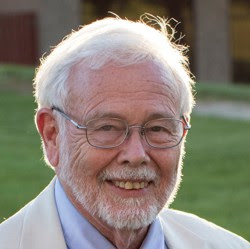By Rev. Dr. Wilson Yates, President Emeritus & Distinguished Professor Emeritus of Religion, Society, and the Arts
In these remarks I am concerned with spirituality and the character of the spiritual journey with a recognition of the arts and their importance as companions on this journey—as companions on our religious pilgrimage. Some of you now reading this brief writing were my students and, perhaps, remember the tenor of these remarks. An earlier version was part of an essay I wrote for ARTS, 24:1, 2012–13.
 Our spiritual pilgrimage or journey is a deep and profound undertaking, for it has to do with the religious questions we seek answers to as we live within the arc of religious faith with its stories, beliefs, images, and community. It has to do with our search for the ultimate meaning of our lives and with the moral life that our spirituality embodies and gives shape to. And, perhaps most significantly, it has to do with the acceptance or denial of a relationship to God or of another primal source of life. What emerges from such engagement is a spirituality that gives definition to who we finally are as religious individuals, as religious people.
Our spiritual pilgrimage or journey is a deep and profound undertaking, for it has to do with the religious questions we seek answers to as we live within the arc of religious faith with its stories, beliefs, images, and community. It has to do with our search for the ultimate meaning of our lives and with the moral life that our spirituality embodies and gives shape to. And, perhaps most significantly, it has to do with the acceptance or denial of a relationship to God or of another primal source of life. What emerges from such engagement is a spirituality that gives definition to who we finally are as religious individuals, as religious people.
This journey, as a journey of a spiritual pilgrim, is a serious undertaking and precisely because of that it is much more than the journey of spiritual tourists who dip into the religious scene when such dips are in season or who go to mountain tops to gain a better view of God. Rather it is an ongoing pilgrimage marked by continuity and commitment, struggle and insight—with insight that can offer a new way of seeing. It is the greatest journey of our lives, for it is concerned with matters of the ultimate meaning and destiny of our lives. But it is also a journey that needs understanding and discipline else it loses itself in the briar patch of spiritual gurus or secular solutions sold in pious wrap.
The spiritual pilgrimage is fraught with difficult questions. It is a journey concerned with the purpose of our being on this earth, with the struggle to define ourselves amidst the brokenness and alienation we experience; it is concerned with our efforts to live a morally responsible life even as the ambiguity of moral action mires us into inaction; and it is a journey where we seek to understand and be present to Whoever God is whether a God removed beyond all of history, all of our comprehension, or a God present within us stirring us as with eagle wings that we might awaken to the possibility of new life. Or a God who is both.
The spiritual journey is not an easy one for those of us who live everyday lives in a secular world, for it calls us to go beyond or, if you will, to go beneath the surface of everydayness. It calls us to commune not with the lightness of being but with the Depths of Being, not with the piety of being but with the threat of non-being, not with the domestication of being but with the startling glimpse of the Ground of Being—of the Spirit of God. A glimpse that comes in our moments of seeing—seeing the petal of the first crocus through the light of the winter’s snow; seeing in a Rembrandt painting the power of Christ’s face to engage us; seeing in our anguish the fall of a black boy’s body from a police bullet’s pierce; seeing in the face of a Ukrainian mother’s tears that which shakes us and bruises our soul. We are given a glimpse of the God who will be there in our facing and living with the mystery of life itself, who will be there in the dark morning light of sleeplessness—a glimpse of the God who will be there in our reaching out to the other in a gesture of kindness, of help, of reassurance. The spiritual experience: it is there in the deep red bloom born on the crooked branches of the blooming Weigela that speak of the crucifixion. But, you see, it is there too, as you listen to the laughter of a child.
How to describe our venture? It is a pilgrimage, a journey of experiences in which we encounter both the frightening fall into the abyss of uncertainty and destructiveness, as well as the joyous moments of the Spirit touching our hearts. And within this paradox we find our spiritual home.
Our spiritual journey. If we choose to undertake it with seriousness then it will move us into the interior spaces of our life as well as that world that seems beyond our grasp; into the dark night of the soul and into the peace that passeth all understanding. It invites us to know that with love comes kindness and mercy, comes our seeking justice in the world—justice that is the social face of love. And our journey invites us to hone that love in the virtues of kindness and courage, forgiveness, and sometimes, before reconciliation and forgiveness are even possible, anger at what innocent people of the world are asked to endure in the face of the evil marshaled against them.
And what of the arts?
A simple assertion: the arts are good and important companions on our spiritual journey. Few would disagree. But I would press the matter further by saying that the arts are not only important companions but are crucial companions upon which we are dependent. For through them—through the sound of notes from the violin and voice; through the images cast in glass and paint, stone and fabric, wood and metal; through the movement of the body in gesture and dance; through the metaphor of poetry, the narrative of story, and the dramatic moment of the play; through the form and shape given in architecture; through the very art that is the liturgy itself—if we engage them fully in a communion of dialogue, they will enable us to understand the contours of our religious faith; to see judgment proclaimed against idolatry and injustice; they will invite us to experience the Divine and create space for the Spirit to move in our soul; and they will help us envision a world made whole. And that after all, lies at the heart of our pilgrimage.
The arts become crucial companions when we realize that works of art—mundane, profane human creations—can become burning bushes that tell us to remove our sandals for we are standing on holy ground, tell us that the One that is “I Am,” the Holy Living God, will speak to us through image and sound, gesture and story, form and space.
To make the point even more pointed, I wish to take worship and its dependence on the arts. We have alluded to the relationship. A continuing albeit brief visit is in order.
Leading to the place of worship, we encounter the architecture of the building whether a rising neo-gothic tower or a storefront church with a cross above the door and, upon entering, worship within the aesthetic design of liturgical space whether simple or elaborate, whether a high altar or a bold central communion table, whether pews seated in rows or chairs in a moon-crest of a circle. We see the minister with a robe and stole and see the paraments on the communion table and pulpit—all forms of fabric art. We know the rudiments of dance in our acts of standing, sitting, folding of hands, bowing of heads, kneeling in prayer—all performed in unison, a choreography of body movement.
We participate in music as we listen to instruments and the choir and as we join in the singing of hymns; we experience the literary arts in the hearing of stories from the Hebrew scriptures and the Christian gospels, from worldly stories and poetry from the Psalms; we see the craft arts in carved wood and pottery, in the shape of the communion cup; we see the visual arts in stained glass and paintings, in sculptures and wood carvings, in the shape of furniture and the color of banners. We engage in a drama in which we are the actors, for worship, Kierkegaard insisted, is a religious drama performed in the presence of God.
All worship of whatever religious tradition is a reenactment of the tradition’s religious story that draws on the arts for its expression. It is not difficult to see how they are crucial to the worship of a people and become necessary forms in the person’s spiritual experience and formation, whether we are speaking of the simplicity of a Quaker Meeting or the elaborateness of an Eastern Orthodox Mass. They may lead us to revolutionary commitment, or they may engage us in reaffirming the traditions of our faith—or perhaps, by necessity, both. Either way, the arts, as earthen vessels, will shape, in the worship life of a people, the relationship we will have with ourselves, with nature, with the world, with God.
The arts can offer hallowing moments, can become burning bushes in our pilgrimage. They can call us into quietness and call us to act in the face of inequities and injustice. You will find the arts, therefore, to be good, indeed, necessary companions on your spiritual pilgrimage.



Your Comments :